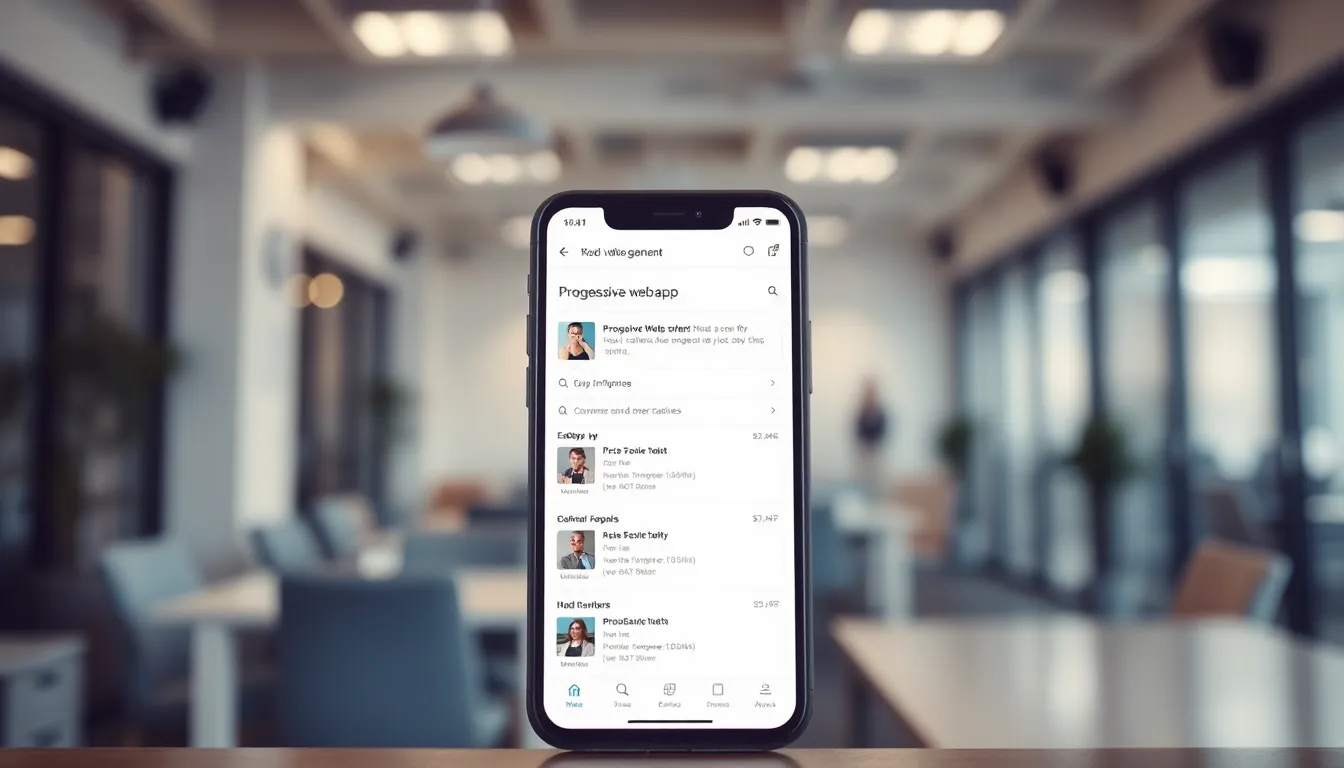Imagine a world where apps load faster than a cheetah on roller skates and work seamlessly, whether you’re on a fancy Wi-Fi connection or that questionable coffee shop hotspot. Enter progressive web apps (PWAs), the superheroes of the digital realm. They combine the best of web and mobile apps, offering users a delightful experience without the hefty download times.
Table of Contents
ToggleWhat Are Progressive Web Apps?
Progressive web apps, or PWAs, blend the best features of web and mobile apps. These applications utilize modern web technologies to deliver a fast, engaging user experience. Speed is a key attribute; PWAs load rapidly, even on unreliable networks. User engagement increases due to their ability to provide smooth interactions.
Offline capabilities distinguish PWAs from traditional web applications. Users benefit from access to content without an internet connection. Service workers handle background processes, enabling this functionality seamlessly.
Another significant aspect revolves around responsiveness. PWAs adapt to various screen sizes and devices. This versatility ensures an optimized experience on smartphones, tablets, and desktops alike. Flexibility is crucial for maximizing user satisfaction and retention.
Installation efficiency enhances the appeal of PWAs. Users can add these apps to their home screens easily without navigating app stores. Once launched, PWAs provide a native app-like experience, complete with full-screen mode and push notifications. Continued engagement with users helps for better communication and timely updates.
Findability through search engines also plays a vital role. PWAs index in search results, allowing users to discover them quickly. This visibility contributes positively to traffic and user acquisition strategies.
Progressive web apps redefine how users interact with digital content. They merge the accessibility of the web with the rich features of mobile applications. This combination leads to improved performance, increased reach, and enhanced user experiences.
Advantages of Progressive Web Apps

Progressive web apps (PWAs) offer numerous advantages that improve user experience and engagement. These benefits stem from the integration of web technology and mobile applications.
Improved Performance
PWAs load quickly, even with slow internet connections. Their lightweight nature minimizes waiting times, enhancing user satisfaction. Caching strategies ensure instant access to frequently used content, leading to seamless interactions. Additionally, their responsiveness adapts to various devices, providing an optimal experience on smartphones and tablets. Metrics consistently show reduced load times, increasing user retention rates. Fast performance ranks as a crucial factor in user experience.
Offline Capabilities
Offline capabilities are a standout feature of PWAs. Users can access content without an internet connection, thanks to service workers that cache assets. This reliability fosters user trust, allowing continued engagement even in poor network conditions. Examples illustrate how PWAs deliver essential features offline, maintaining operational integrity. Moreover, the ability to sync data once the device reconnects enhances usability. More businesses are leveraging this advantage to reach users in diverse environments.
Enhanced User Engagement
Enhanced user engagement defines the success of PWAs. Push notifications keep users informed about updates and offers, encouraging them to return. Features like full-screen mode create an immersive experience, resembling native applications. Easy installation on home screens reduces friction and invites ongoing interactions. Metrics indicate that PWAs lead to higher conversion rates and increased time spent on sites. Captivating user experiences foster brand loyalty, as users appreciate the convenience and functionality.
Key Technologies Behind Progressive Web Apps
Progressive web apps rely on several key technologies that enhance their functionality and user experience.
Service Workers
Service workers act as a proxy between users and the network. This technology enables background processes like caching, which allows PWAs to load quickly even in poor network conditions. Users benefit from this enhanced speed, as content becomes accessible almost instantly. Offline functionality is another critical feature offered by service workers, allowing users to interact with apps without needing an internet connection. These capabilities contribute significantly to user satisfaction, driving continued engagement.
Web App Manifest
The web app manifest file serves as a configuration blueprint for PWAs. It provides essential metadata like the app’s name, icons, and theme colors. This file helps define how the app appears when saved to a user’s home screen. Users experience a more cohesive identity across devices, aligning closely with their expectations for native apps. Additionally, the manifest supports features like full-screen mode and splash screens, enhancing the app’s usability.
Responsive Design
Responsive design ensures that PWAs adapt seamlessly to various devices and screen sizes. This technology enhances accessibility by adjusting layouts based on the user’s device specifications. Users enjoy a consistent experience whether they access the app on a smartphone, tablet, or desktop. With responsive design, PWAs maximize user engagement by delivering content that fits perfectly within the user’s viewing area. This adaptability plays a significant role in improving overall user satisfaction and retention.
Getting Started with Progressive Web Apps JavaScript
Progressive Web Apps leverage modern web technologies to provide an enhanced user experience. Developers can utilize various frameworks and libraries to build these applications efficiently.
Frameworks and Libraries
Numerous frameworks and libraries simplify the development process of PWAs. React offers a component-based architecture, enhancing reusability and maintenance. Angular, with its robust tooling and features, supports complex applications with ease. Vue.js provides flexibility and is suitable for both small and large projects. These tools often come with built-in features like routing and state management, streamlining development workflows. Developers should choose a framework based on project requirements and team expertise, aiming for fast load times and responsive designs.
Building Your First PWA
Creating a PWA starts with planning the app’s structure. Set up an HTML file that anchors the app’s interface, ensuring a solid foundation. Incorporate a service worker to manage caching and offline capabilities. Register the service worker in the main JavaScript file for it to function properly. Implement a web app manifest containing metadata like the app’s name, icons, and theme colors, which defines its appearance when installed. Testing the PWA across different devices ensures responsive behavior and usability. With these steps, developers will establish a strong base for future enhancements and performance improvements.
Progressive web apps represent a significant advancement in the way users engage with digital content. By merging the best features of web and mobile applications, PWAs offer a seamless experience that prioritizes speed and accessibility. Their ability to function offline and adapt to various devices enhances user satisfaction and retention.
As developers embrace modern technologies like service workers and responsive design, the potential for creating high-performing applications continues to grow. The ease of installation and discoverability through search engines further positions PWAs as a valuable asset for brands aiming to enhance user engagement. Adopting PWAs can lead to improved performance and increased brand loyalty, making them a smart choice for businesses in today’s digital landscape.



